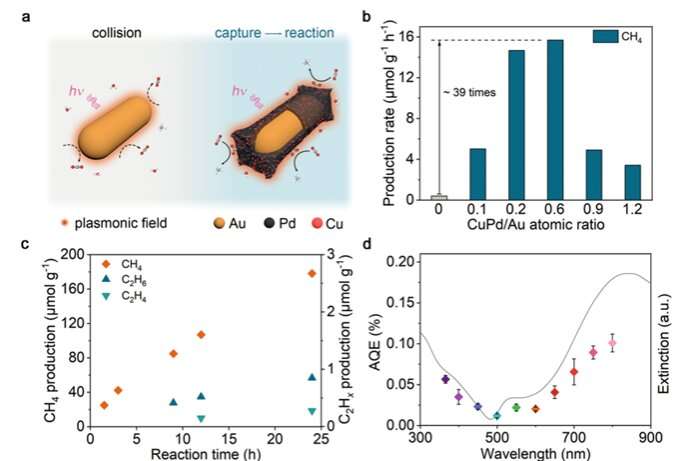This article has been reviewed according to Science X's editorial process and policies. Editors have highlighted the following attributes while ensuring the content's credibility:
fact-checked
peer-reviewed publication
proofread
Highly efficient, near-infrared-featured CO2 reduction by surface plasmon

To synthesize hydrocarbons via sunlight, CO2 and water is commonly seen in the nature, especially in the plant kingdom, but it remains an inviting challenging in science amidst growing interest in pursuing new and clean energy. Recently, a research team led by Prof. Xiong Jieyu from the University of Science and Technology of China (USTC) reports a broadband plasmon-induced CO2 reduction reaction, which achieves a CH4 production rate of 0.55mmol g-1 h-1 with 100% selectivity to hydrocarbon products. The work is published in Nature Communications.
Artificial photosynthesis could usher in a promising energy future, bypassing the exhaustion of coal and oil resources. The method has been studied for many years and gets stuck in the low utilization efficiency of low-energy photons, especially near-infrared photons. A mass of semiconductors and metal nanocatalysts have been studied to solve the problem. Among them, plasmonic metal nanoparticles have proved their capacity in absorbing low-energy photons but fail in energy coupling into the reactant molecules.
Researchers in Prof. Xiong Jieyu's team focused on solar-to-chemical energy conversion and optimized the system by employing versatile co-catalysts to establish an effective bridge for transferring hot carriers from plasmonic materials into reactant molecules.
They found that the localized electric field could lead to the emergence of a new isolated state above the Fermi energy and the differentiation of electron transfer within different molecular orbitals, thus enabling such a unique artificial photosynthesis process. Through their method, they have eventually achieved an extraordinary CH4 production rate of 0.55 mmol g-1 h-1 via a gas-solid biphase system, which is a record high.
The work breaks a long-standing block and proves the viability of low-energy photon utilization and efficiency improvement of the solar spectrum. Also, it provides a riveting picture of the potential of plasmon-induced catalysis toward achieving broadband artificial photosynthesis and makes artificial photosynthesis move further toward techno-economic applications.
More information: Canyu Hu et al, Near-infrared-featured broadband CO2 reduction with water to hydrocarbons by surface plasmon, Nature Communications (2023). DOI: 10.1038/s41467-023-35860-2
Journal information: Nature Communications
Provided by University of Science and Technology of China





















